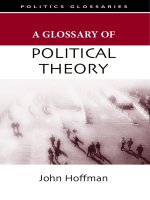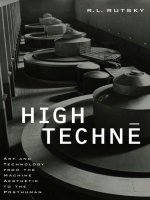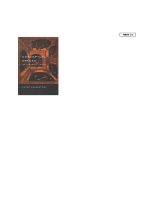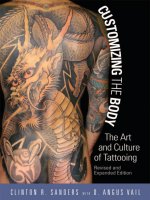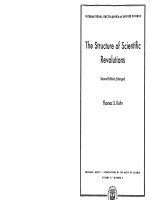univ of minnesota press french colonial documentary mythologies of humanitarianism mar 2008
Bạn đang xem bản rút gọn của tài liệu. Xem và tải ngay bản đầy đủ của tài liệu tại đây (7.62 MB, 281 trang )
French Colonial Documentary
University of Minnesota Press / Minneapolis • London
French Colonial Documentary
Mythologies of Humanitarianism
Peter J. Bloom
A previous version of chapter 3 was published as “Trans-Saharan Automotive Cinema: Citroën-, Renault-, and
Peugeot-Sponsored Documentary Interwar Crossing Films,” in Virtual Voyages, ed. Jeffrey Ruoff (Durham,
N.C.: Duke University Press, 2006), 139–56; reprinted with permission of Duke University Press. Portions of a
previous version of chapter 4 were published in “Hygienic Reform in the French Colonial Film Archive,” Journal
of Film Preservation 63, no. 1 (November 2001): 17–24; reprinted with permission. Portions of an earlier version
of chapter 4 appeared as “Invisible Agents: Diagnosing French Colonial Interwar Cinema,” in (a): the journal
of culture and the unconscious 1, no. 2 (2000–2001): 76–92; reprinted with the permission of (a) and the California
Psychoanalytic Circle.
Frontispiece: Reinhard Scheibner, Mit Glans und Gloria, 1995. From Reinhard Scheibner, Lino-Métal: Compilation
Gravures, August–September 2001, Dernier Cri, Marseille, France. Courtesy of Reinhard Scheibner.
Copyright 2008 by the Regents of the University of Minnesota
All rights reserved. No part of this publication may be reproduced, stored in a retrieval system, or transmitted,
in any form or by any means, electronic, mechanical, photocopying, recording, or otherwise, without the prior
written permission of the publisher.
Published by the University of Minnesota Press
111 Third Avenue South, Suite 290
Minneapolis, MN 55401-2520
Printed in the United States of America on acid-free paper
Library of Congress Cataloging-in-Publication Data
Bloom, Peter J.
French colonial documentary : mythologies of humanitarianism / Peter J. Bloom.
p. cm.
Includes bibliographical references and index.
ISBN-13: 978-0-8166-4628-9 (hc : alk. paper)
ISBN-10: 0-8166-4628
-7 (hc : alk. paper)
ISBN-13: 978-0-8166-4629-6 (pb : alk. paper)
ISBN-10: 0-8166-4629-5 (pb : alk. paper)
1. Documentary films—France—History and criticism. 2. France—Colonies—History—20th century. I. Title.
PN1995.9.D6B59 2008
070.1'80944—dc22 2007043302
The University of Minnesota is an equal-opportunity educator and employer.
1514131211100908 10987654321
Introduction: French Colonial Documentary
vii
1. Tupi or Not Tupi: Natural Man and the Ideology of
French Colonial Documentary
1
2. Mythologies of the Tirailleurs Sénégalais: Cinema, Shell Shock,
and French Colonial Psychiatry
35
3. The Trans-Saharan Crossing Films: Colonial Cinematic Projections
of the French Automobile
65
4. Diagnosing Invisible Agents: Between the Microbiological
and the Geographic
95
5. Infiltrate the Crowd with an Idea! Colonial Educational Cinema
and the Threat of Imitative Contagion
125
6. Humanitarian Visions and Colonial Imperatives: Félix-Louis Regnault,
Albert Kahn, and Henri Bergson as Semiophore-Men
153
Contents
Conclusion. The French Colonial Media Apparatus: Natural Man
and the Dialectics of Americanization
183
Acknowledgments
199
Appendix: Archives and Film and Media References
203
Notes
217
Index
257
Several themes present in this book crystallized unexpectedly when I attended a March
2006 lecture by Nicolas Torrenté, the U.S. executive director of Doctors without
Borders (Médecins Sans Frontières, or MSF), at the University of California–Santa
Barbara, where I currently teach. Torrenté presented a survey of humanitarian actions
that MSF—winner of the 1999 Nobel Peace Prize and international humanitarian orga-
nization par excellence—undertakes in various regions of Africa, the Caribbean, South
America, Asia, the Middle East, and beyond. A primary argument justifying the work
of MSF is the need for a narrow humanitarianism that involves assisting communi-
ties in the throes of human catastrophes, including acts of nature and wars that affect
various non-Western populations who cannot fend for themselves. These humanitar-
ian disasters are rarely reported in the news media. MSF contends that most people
in the West are simply unaware that they are occurring, and if better informed they
could be led into action. Upon hearing these arguments and seeing an array of dis-
turbing video clips as part of a PowerPoint presentation, I sensed the presence of French
colonial humanitarianism as a specter in the lecture hall.
Footage of suffering people in the Congo, Sudan, Haiti, and elsewhere was rem-
iniscent of the imagery used during the interwar period to justify French colonial
humanitarian intervention. In fact, the images presented at this fund-raising event,
masked as a lecture, had a powerful quality of abjection absent in most of the French
colonial documentary footage and feature films discussed in the chapters that follow.
In this book I argue that the power of the documentary image was intimately con-
nected to the photographic construction of truth in the name of an evolutionary logic
of civilization that was used to justify the imposition of French colonial authority. In
other words, visual representations of an anarchic, pre-civilized state of being justified
Introduction
French Colonial Documentary
vii
colonial intervention in the name of a biopolitics of civil and social rights. Further,
photographic reconstructions of the primitive state of human civilization created a
context for colonial interventionism as a scientifically constructed medical and hygienic
discourse of social reform that projected a catoptrics of national, educational, and sec-
ular revival under the Third Republic (1870–1940) onto the colonies.
The rhetoric of a call to action by MSF in the name of unremitting humanitar-
ian disasters around the globe repackages colonial humanitarian interventions. The
high-protein, patent-pending plumpy’nut® food supplement, packaged for children
who want to identify with astronauts but given to suffering adults alike, was featured
as a sample of the new technologies used to save lives in disaster-stricken areas. Fur-
ther, the MSF project mobilizes “technologies of disaster” in the name of an apoliti-
cal form of humanitarian action.
1
A crucial point, however, is the function of the
endangered life as the justification for moral action, with victims depicted as existing
in a state of exception, beyond the sovereignty of the state and without rights as citi-
zens. It was in the name of global citizenry that the audience was rhetorically being
hailed into a realm of “good works” in the name of humanity. Representing victim-
hood in this way refers to an important element in Giorgio Agamben’s discussion of
“bare life,” where he writes: “He who will appear later as the bearer of rights and,
according to a curious oxymoron, as the new sovereign subject . . . can only be con-
stituted as such through the repetition of the sovereign exception and the isolation of
corpus, bare life, in himself. . . . If one can speak . . . of ‘law’s desire to have a body,’
democracy responds to this desire by compelling law to assume the care of this body.”
2
This “state of exception” transforms the human subject into “bare life” and con-
tradicts the role of the body as subject to the laws of the sovereign, which in turn
justifies a state of affairs that creates the law. An ultimate form of complicity between
the infrastructure of structured global capital flows and self-administered antidotes
attempts to regulate the conditions of disaster. When disaster strikes, it is often a mat-
ter of whether there are structures in place to contain the disaster and avert its most
dire consequences. As I describe in chapter 4, at the beginning of the twentieth cen-
tury averting medical and hygienic disaster was directly associated with international
efforts to find a cure for sleeping sickness in Uganda, Angola, the French Congo, and
the Congo Free State. This early form of humanitarian action was motivated largely
by the colonial powers’ economic interests in indigenous labor used to cultivate and
gather wild rubber on colonial plantations for the export economy. Retroactive colo-
nial humanitarianism justifies economic exploitation by finding the cure to the effects
of colonial intervention. Finding the cure not only justifies the suspension of sover-
eignty rights under the colonial administration but perpetuates a system of inequality
founded on the magical promise of technological modernity.
Admittedly, I attended the MSF lecture expecting a familiar apolitical vision of
global humanitarianism given the recent history of MSF. The organization was initially
composed of doctors interested in intervening politically on the basis of humanitarian
rights, taking the side of the Biafrans in the 1967–70 Nigerian War in which Bernard
viii — Introduction
Kouchner publicly criticized the complicity of the Red Cross with the Nigerian gov-
ernment. Kouchner joined with Raymond Borel to create MSF in 1971, but the organi-
zation became more politically neutral with new leadership and through the expansion
of its mandate by the end of the 1970s. MSF’s secular humanitarian readiness has
much in common with the legacy of the Pastorians, a cadre of French medical assis-
tants and professionals who upheld Louis Pasteur’s principles of social, hygienic, and
medical reform in France and the colonies during the interwar period.
The evocation of an imperial global humanitarianism and the rhetorical tactics
of rallying ecologically conscious potential donors in Santa Barbara in a European
form of consciousness-raising mark another example of niche-marketed activism. The
university-sponsored lecture was a means of evoking the normally invisible racialized
“other” while laundering a vague sense of guilt for their inattention to and insularity
from such questions. In the media flow of victimization, the throbbing head, bulging
eyes, and shrunken body of the victim cries out for help to the consuming individu-
ated Western subject, who can pay for a life by choosing to donate income that would
otherwise be spent on the frivolity of attending the opera, installing a swimming pool
in the backyard, or buying a bloated but possibly hybrid sports utility vehicle. Such
arguments attempt to frame humanitarian action in opposition to the culture of con-
sumptive gluttony.
An essential point of this book is not, however, to resolve the conundrum of a
hierarchy of needs but rather to analyze the myths that underlie how the figure of the
geographically remote “victim” figured in French colonial humanitarian conscious-
ness during the interwar period. If the rhetoric of humanitarianism has shifted away
from the development of a national consciousness, it remains with us, wrapped in lay-
ers of imperial hubris simultaneously unraveling and being reinvented across national
boundaries. In the spirit of global capital flows, several of the better-known non-
governmental organizations (NGOs) circulate in the same social orbit of international
corporate capital that exists in parasitic relationship to the increasingly indistinguish-
able international corporate and political class of actors. Or, as Agamben puts it, they
“[maintain] a secret solidarity with the powers they ought to fight,” thus depoliticizing
disaster, obstructing an understanding of its local and global contexts, and producing
victims as passive ciphers devoid of political agency.
3
Co-opting local suffering as
international interventionism is categorically separated from the circumstances that
create the disaster in the first place. The transformation of the humanitarian ethic into
NGOs has its origins in nineteenth-century nation-state building projects grounded
in ideas about geographic difference and successive constructions of “natural man.”
This book addresses the parameters of French colonial documentary cinema as a
history of a French colonial media apparatus. It does this in the spirit of understand-
ing the rhetorical claims for humanitarian responsibility founded on security, human
catastrophe, and civilization. The “apparatus,” a term rooted in a psychoanalytic and
Marxian analytic paradigm, is at once a machine that produces meaning and an over-
determined political and social context that forms the basis for ideology.
4
It is for this
Introduction — ix
reason that chapter 1 begins with an analysis of the history of ideology in eighteenth-
century Europe. In a survey of film-related inventions, scientific methods, and doc-
uments used to measure and visualize geographic difference, I explore a series of
interrelated archives that illustrate how they served as the basis for the creation of a
series of humanitarian myths that were primarily focused on remaking the French male
body in relation to “natural man” from the Franco-Prussian War (1870–71) until the
end of the interwar period (1918–40) of the Third Republic (1870–1940).
The transformation of “natural man” as a recurring figure beginning with Jean-
Jacques Rousseau’s De l’inégalité parmi les hommes (Discourse on the Origin of Inequality,
1755) was grounded in the history of physiology and gymnastic training and incorpo-
rated into the project of French colonial reform. The title of this book, French Colo-
nial Documentary, refers to a corpus of documentary films that were made from the
dawn of chronophotography in the late nineteenth century to the end of the interwar
period, but also to an intersecting photographic and visual archive that simultaneously
infiltrated and provided an authoritative context for colonial consciousness.
In chapter 2 I discuss the relationship between an archive of imagery and psy-
choanalytic categories defined through the projection and internalization of these images
in relation to the history of the Tirailleurs sénégalais, or Senegalese Sharpshooters.
Beginning with Roland Barthes’s well-known analysis of the saluting soldier as the ex-
emplary figure of French imperialism, I argue that Barthes’s misrecognition of the figure
in the photograph on the cover of Paris-Match is symptomatic of a broader history of
misrecognitions depicting an evolutionary iconography of childhood—materialized
as Bamboula, the “y’a bon” buddy, used to promote Banania, the French breakfast
cereal. I examine representations of the Senegalese Sharpshooter through an archive
of early postcards and documentary films that locate this figure as the sentinel of the
French colonial empire. Initially renowned in France for their service in Morocco, the
Tirailleurs sénégalais became famous for their service in Europe during World War I.
I examine the manipulations of stereotyped imagery and its relationship to the his-
tory of shell shock, colonial psychiatry, psychoanalysis, and subsequent critiques.
Whereas the myth of the Senegalese Sharpshooter is focused on the body and ges-
tures of the figure himself, it is the geographic mise-en-scène that serves as the focus
of chapter 3. Through an examination of the interwar trans-Saharan crossing films
sponsored by the automobile manufacturer André Citroën, I explore how the Saharan
Desert figured in the French colonial imagination as the ultimate decompression cham-
ber of the West. The crossing films were an extension of a longstanding national vision
of creating a railroad itinerary to link Algeria to sub-Saharan Africa. In addition to
outlining the expeditions and the never-completed Transsaharien Railroad project, I
examine the role of the automobile as the foundational mode of transportation, which,
in turn, became intricately associated with the film camera. The crossing vehicles them-
selves, like the mechanisms of a watch, were cued to the temporal structuring of the
motion picture camera in their kinematic functionality. French colonial documentary
is typically associated with the archive of Citroën films because of the way in which
x — Introduction
colonial geography became the ultimate vanishing point for a myth of humanitarian
values in the machine aesthetics of modernity. The automobile and the camera became
symbols of humanitarian action and the construction of tourist adventure. In the
aftermath of the nine-month Croisière Noire (Black Cruise) expedition (1924–25), a
well-attended exhibition of objects and films from the journey was held at the Musée
des Arts Décoratifs, contributing to an evolving geographic mental picture of an Afri-
can mise-en-scène in the metropolitan exhibitory imagination. Further, the crossing
expeditions came to define French colonial documentary as an experience and genre
of masculine adventure.
Making the colonies visible was focused not merely on a network of sites within
the French colonial domain, but, as I illustrate in chapter 4, on diagnosing invisible
agents that can be detected only by technologies of vision and know-how. Techniques
of magnification and rendering the invisible visible as part of a medical discourse of
hygienic reform drew on the scientific authority of photographic representation to
make arguments about the social and moral imperative to transform the colonial land-
scape. In analyzing a 1924 short-subject film about sleeping sickness titled Trypanosoma
gambiense: Agent de la maladie du sommeil (Gambian trypanosomiasis: The agent of
sleeping sickness), I describe how techniques of editing and magnification support
the construction of medical and hygienic authority. I also discuss the evolution of the
educational medical hygiene films in France and the colonies initiated by the French
parasitologist Raphaël Blanchard and address the impact of the Rockefeller-sponsored
film hygiene campaigns mounted immediately following World War I.
In addition to promoting a medical infrastructure for colonial reform, colonial
documentary was a government-sanctioned initiative subsequently redefined by the
1931 Parisian Colonial Exhibition, as I discuss in chapter 5. Instilling colonial conscious-
ness among French citizens during the interwar period was directly integrated into a
series of French colonial documentary initiatives. In addition to several films commis-
sioned expressly for the 1931 exhibition, educational cinema was the basis for colonial
documentary. Some of the earliest and best-developed efforts began in French Indo-
china under the tutelage of Albert Sarraut, the well-known architect of French colo-
nial policy during the interwar period. Initiatives to produce colonial documentary
films drew on advertising techniques and the discourse of crowd psychology in order
to promote an ethic of colonial consciousness. The title of chapter 5, “Infiltrate the
Crowd with an Idea!” refers to the perceived instability of the crowd and the need to
manipulate its purportedly infantile undulations through the application of commu-
nication techniques in the service of geopolitical containment.
In chapter 6 I study a series of chronophotographs of a female Wolof potter as
the starting point for ethnographic film and discuss the terms of its emergence in the
history of anthropology. This history became associated with the role of educational
film as a supplement to the study of human geography and with Albert Kahn’s pro-
ject known as Les Archives de la Planète (Archive of the Planet), which served as the
basis for the early documentary film collection at the French National Film Archives.
Introduction — xi
This archive was conceived as a map of the world through Lumière color autochrome
photography and documentary films financed by Kahn himself. Through a discussion
of various expeditions that he sponsored, I analyze the context for obtaining these
images and their role in the broader terms of internationalism and a Bergsonian vital-
ist approach to asserting the authority of the photographic image as the sign of mean-
ingful difference and a basis for political action.
Some of the initiatives developed by Kahn carried over into the work of the League
of Nations’ Institute for Intellectual Cooperation (CIC). Henri Bergson’s involvement
with Kahn’s initiatives and service as the first president of the CIC was significant, I
argue, because of the way in which philosophical arguments about duration in par-
ticular became associated with institutional priorities of the period. In this context I
discuss the debate between Bergson and Einstein on the nature of relativity and dis-
cuss how Bergson’s reading of Einstein’s work reinforced colonial imperatives by claim-
ing that there is one master clock as opposed to separate clocks indicating times that
can never be reconciled. Totalizing concepts of difference and projecting them informed
the work of Kahn’s Archives de la Planète, the CIC, and the League of Nations’ Rome-
based International Institute for Cinematographic Education.
The book concludes with a return to the theme of “natural man” and suggests
potential sites for his reinvention. As another type of performance spectacle, related
to the figure of “primitive man” illustrated in my discussion of Antoine and Lugeon’s
1928 film Chez les mangeurs d’hommes (Land of the Cannibals) in chapter 1, African
American boxers (Jack Johnson and Panama Al Brown) served as positive images of
America for the Parisian avant-garde, signaling the materialization of natural man in
dialectical opposition to the negative view of Americanization as Protestant uplift, stan-
dardization, Taylorization, and Fordism. As a counterweight to the positive image of
the African American performer as natural man, the Senegalese boxer Battling Siki,
who defeated Georges Carpentier in a reportedly fixed match, presented a negative
vision of natural man because of his identification as a colonial subject dethroning the
French champion who symbolized a French gymnastic ideal. The semiotic square that
I just described repositioned the role of natural man through the popular sporting
spectacle of boxing in an emerging international media apparatus during the interwar
period that redistributed values of masculinity and colonial difference.
In the final chapter I also discuss the role of French masculinity in relation to
Cocteau’s stint as Brown’s short-lived boxing manager and his analysis of feminine dis-
play in the case of the American trapeze artist Barbette. The masquerade of civilized
femininity in relation to the racialization of “natural man” can finally be understood
as contributing to the elaboration of a colonial media apparatus that drew on the his-
tory of bodily training at the intersection between black American boxing and French
gymnastic techniques.
Research for this work has been conducted at archives in France and the United
States and was initially connected to debates concerning the role and significance of
colonial iconography in France during the 1990s. Most of the research related to the
xii — Introduction
films examined in this project were initially screened with colleagues in France work-
ing in an orbit of researchers connected to an associative structure known as Associa-
tion des Connaisances Historiques de l’Afrique Contemporain (ACHAC),
5
but actual
access to the films was crucially undertaken over an extended period at the French
National Film Archives, while the collection of colonial films was being evaluated by
Youssef el Ftouh with Manuel Pinto. In fact, without the support of Eric Le Roy and
Michèlle Aubert at the Archives du Film at the Centre National du Cinématographie–
Bois D’Arcy I would not have been able to screen these films or embark on research
that has since led me further afield. Eric Le Roy writes that more than a thousand
French colonial films were produced from 1896 to 1955, and only 820 have survived.
6
Interrogating the relationship between French documentary realism and the colonial
enterprise is the central focus of this book. While Le Roy’s useful filmographic cate-
gorization of colonial cinema addresses, among others,
7
films that were filmed in the
French colonies, I extend the parameters of colonial documentary as archive, myth,
and visual index to the discourse of humanitarianism.
Introduction — xiii
This page intentionally left blank
Jean-Jacques Rousseau’s vision of a carefree, healthy, and happy “natural man” in oppo-
sition to a degenerate “civilized man” is deeply etched into the Western imagination.
While Rousseau’s well-known De l’inégalité parmi les hommes (Discourse on the Origin
of Inequality, 1755) argues that civilization creates more ills than it can remedy, succes-
sive generations of nineteenth-century French hygienic reformers claimed that “civi-
lization” improves health conditions and the general quality of life.
In this chapter I trace successive representations of “natural man” as they pertain
to the legacy of ideology and the origins of French colonial documentary cinema. As
an emergent mode of perception, the cinema drew on the legacy of the human sci-
ences and later became a primary means of representing “natural man” in conjunction
with a primitivist revival. Visual technologies used to measure and classify difference
are inscribed into the very foundation of the French colonial encounter. An important
starting point for arguments against Rousseau’s positive vision of natural man can be
found in the work of François Auguste Péron, the “pupil zoologist” who accompanied
Nicholas Baudin on his voyage to Australia in 1800. While traveling with Baudin,
Péron conducted some of the earliest anthropometric measurements on foreign soil
by using a device known as the dynamometer to answer questions about the natural
state of human existence. The superior physical strength of “savages” was thought to
parallel their sexual instincts and desires. Péron, however, challenged the accepted
wisdom that civilization led to the increased sublimation of the sexual instinct and
hence to a diminished capacity for physical strength. He marshaled his measurements
to prove the very opposite, that is, that civilization lends itself to increased physical
capacity and sexual prowess. Through two kinds of measurements conducted with the
1. Tupi or Not Tupi
Natural Man and the Ideology of French Colonial Documentary
“Tupi or not tupi, that is the question.”
—oswald de andrade,
The Anthropophagic Manifesto (1928)
1
Figure 1. François Péron (1775–1810), naturalist and author of Voyages aux terres australes, sitting at his
desk fifteen days before his death. Drawn by C. A. Lesueur, 1810. In Voyage de découvertes aux terres australes,
exécuté sur les corvettes le Géographe, le Naturaliste, et la goëlette le Casuarina, pendant les années 1800, 1801,
1802, 1803, et 1804, ed. Louis Freceynet (Paris: Impr. impériale, 1807–16). Copyright Bibliothèque Nationale.
dynamometer, Péron ranked the capacity for civilization manifested by three groups
of Australian aborigines in relation to French and British test subjects.
The British test subjects were consistently stronger than the French, a difference
Péron attributed to the relative health of the test subjects after their long and treach-
erous journey. The results of Péron’s study, reported in “On the Physical Strength of
Savages,” were considered credible upon his return to Paris.
1
Their scientific value was
refuted only, as Jean Jamin suggests, more than fifty years later in the context of mid-
to late nineteenth-century evolutionary debates initiated by anthropologist Armand
de Quatrefages.
2
Crucially, the dynamometer also represents an ideological physiology
associated with the development of chronophotography, that is, serial motion pho-
tography, by Etienne-Jules Marey. The transformation of philosophical ideas about
the nature of sensation into a series of scientific experiments led to the development
of a cinematographic instrument used to measure and visually reproduce movement
in time. It is this Sensationalist legacy of cinema that became a source of colonial knowl-
edge about the world in the register of cinematic realism. In the archive of Sensation-
alist thought, narrative fragments foregrounding a differential hierarchy of sensation
formed the basis for French colonial documentary cinema. An accomplished expres-
sion of the French colonial documentary form is best examined in André-Paul Antoine
Tupi or Not Tupi — 3
Figure 2. Edme Régnier’s dynamometer illustrated in two positions: measurement of abdominal strength (S);
measurement of strength in hands and arms (R). Jean-Baptiste Rondelet, “Expériences avec le dynamometre de
Régnier,” in Traité théorique et pratique de l’art de bâtir, vol. 2 (Paris, 1804), 21. Copyright Bibliothèque Nationale.
and Robert Lugeon’s Chez les mangeurs d’hommes (Land of the Cannibals, 1928), which
uses the trope of cannibalism in the South Pacific as its narrative hook.
Ideology, Cinema, and Sensationalism
The legacy of “natural man” begins with conceptions of ideology. It is at the intersec-
tion between natural man and ideology that the cinematographic apparatus can be
understood in relation to French colonial documentary. The natural, wild, and sav-
age properties of humankind are presented along an evolutionary axis of civilization
that was subsequently transformed into mimetic techniques of audiovisual representa-
tion. The history of ideology as it relates to the cinematographic apparatus is not merely
a question of how cinema mediates representations of the real as addressed in the writ-
ings of Jean-Patrick Lebel and Jean-Louis Comolli during the 1970s,
3
but the specifi-
cally Kantian question of how we know the world. In Anthropologie in pragmatischer
Hinsicht (Anthropology from a Pragmatic Point of View, 1797), assembled from a series
of lectures delivered near the end of his life, Immanuel Kant set out to interrogate
“how we know the world” by undertaking a systematic treatment of mankind. While
4 — Tupi or Not Tupi
Figure 3. Title card for Chez les mangeurs d’hommes (Land of the cannibals), 1928. Copyright Collection des
Archives du Film et du Dépôt Légal du Centre National de la Cinématographie.
Kant acknowledged the prescience of a physiological knowledge of “man” that seeks
to understand “what Nature makes of man,” he asked what “man” makes of these sen-
sory attributes as a freely acting being.
4
Kant formulated his anthropological perspec-
tive as “knowledge of the world” beginning with an interior investigation of the human
faculties in search of universal forms. His emphasis on the willed nature and selective
deployment of the human faculties remains paramount to the development of a prag-
matic perspective.
Simultaneously in France, a materialist-based Sensationalism served as the foun-
dation for acquiring objective knowledge under the influence of the idéologues, who
were preoccupied with questions of how to distinguish the internal workings of the
mind, the production of thought, and the observation of the natural world.
5
The
human being as a unity was posited as a machinelike organism with an internal phys-
ical and psychic ordering that exists in relation to its sensory capacity to perceive the
world. This conception of the human organism does not simply reinscribe John Locke’s
insistence on reflection as well as sensation, but serves as the physiological and gram-
matical foundation for ideology.
While much of the discussion to follow charts the history of ideology within the
terms of the philosophical tradition of French Sensationalism (or Sensualism), I sug-
gest that cinema might be understood as an ideological apparatus that is integral to
defining and expanding human perceptual fields of inquiry.
6
By invoking chronopho-
tography and machines that are part of an archive of inventions that sought to repli-
cate and magnify the human capacity for perception, I draw out cinematic invention
in the realm of physiological perception. As an educational device, cinema serves as
an instrument used to train the human mind; it functions as a scientific technique for
the observation of the natural world through the expansion and magnification of the
human senses.
At the beginning of Élémen[t]s d’idéologie (Elements of ideology, 1801), the
eighteenth-century French idéologue Destutt de Tracy proclaims that “ideology is part
of zoology.” This statement inaugurates a longstanding lineage between ideology and
the scientific observation of the natural world, which lends itself to the unfolding of
a “naturalist pedagogy.” This conception of ideology defines two poles within the devel-
oping Western ideology of the natural world: an ideological physiology that addresses
the physical and biological parameters of human sensibility and an ideological ratio-
nality that refers to the psychological and logical aspects of the human mind.
7
In an
interrogation of the shared history of scientific modes of observation and the heritage
of the moving image, ideology represents the initiation of an emerging scientific ped-
agogy in search of representational objects.
A physiological ideology serves as a generative reference point from which to ana-
lyze the development of scientific instruments used to measure the “physical and bio-
chemical dimensions of human sensibility.” In the French Enlightenment tradition,
the evolution of a physiological ideology is positioned in terms of Abbé de Condillac’s
Traité des sensations (Treatise on the sensations, 1754) and his discussion of endowing
Tupi or Not Tupi — 5
a sculpture with human qualities. Condillac’s treatise outlines the application of a
rational aesthetics to human qualities. He underscores the sense of touch as the ele-
mental sensation because it is precisely with the sense of touch that animal life begins.
8
Condillac’s metaphor of endowing a sculpture with human qualities was subsequently
adapted to a civilizing model in which the rational geometry of pure sculptural form
is transformed into a realm of human sensation.
A Condillac-inspired notion of ideology also ties the cinematographic apparatus
to the history of cinema as a device for measuring and magnifying bodily sensation.
This Sensationalist rendering of cinema also suggests that graphic methods of inscrip-
tion used to measure internal bodily signs with a pulse writer—the predecessor to the
electrocardiogram—served as the foundation for an experimental device used to record,
reproduce, and diagnose bodily movements. As an inventor of chronophotography,
Jules-Etienne Marey pioneered the development of graphic writing as a viable diag-
nostic form within the French physiological tradition.
The “invention of cinema” as rather a nonteleological event with multiple origins
can be meaningfully traced to the French ideological tradition of materialist thought.
More than simply an inventor, Marey was a pivotal figure within French physiology.
His work and the research conducted at the experimental station known as the Insti-
tut Marey point to a vision of the cinematic apparatus as an experimental means to
picture motion in space and time.
9
Conceived as a scientific instrument, this render-
ing of “ideology and cinema” is an early dominant that positions the role of spectacle
and reception as an effect of the popularization of scientific approaches.
As a historically grounded representational system of knowledge, the developing
terms of ideology serve as an indexical site for the observation and critique of human
affairs. Integral to the systematic examination of the natural world, the study of man
as a zoological creature lends itself to a series of classificatory schemata intended to
map out the nature of mankind, its morphology, and its sensory realm. While biol-
ogy, economics, and philology have come to define the nodal points of an ideological
science in the work of the idéologues, the trajectory of the concept of ideology owes
much to contextualizing and systematizing an object of study. If ideology is part of
zoology, man is part of a zoological system grounded in physiology and rationality.
This evolutionary conception of man as descendant from the animal kingdom initi-
ates a search for the biological origin of thought and its representation.
The Société des Observateurs de l’Homme (Society for the Observation of Man,
hereafter Société, 1799–1805)—founded by Louis-François Jauffret and composed pri-
marily of intellectual figures from the circle of the idéologues, including Destutt de
Tracy—initiated a series of investigations into the natural sciences. The moral and
conceptual framework of these investigations was established through a series of case
studies. The search for universality throughout humankind led to numerous demonstra-
tions of pathologies, including a comparison of skeletal morphologies and a profound
interest in the study of physiognomy and movement. In the founding statement of
the Société, Jauffret claimed that “the observation of physical man is intimately linked
6 — Tupi or Not Tupi
to man’s morality; furthermore, it is practically impossible to study the body or the
spirit in isolation.”
10
Pierre-Jean-Georges Cabinas, a member of the Société and an intellectual figure
associated with the idéologues, was especially concerned with how Sensationalism could
be translated into the thought process. To express the character of this action, Cabinas
established a well-known analogy that equated the way the brain produces thought
to the way the viscera—the brain, stomach, and sexual organs—act on nutrients.
11
Processes internal to bodily functioning were thus positioned as equally important
and worthy of study as the apprehension of the sensory. In effect, Cabinas ushered in
the study of illness and health as key to understanding human psychology, anticipat-
ing the nineteenth-century school of psychophysiology, which linked the physical and
the moral.
More generally, this very indissociability of the moral spirit and the physical body
in the work of the Société was also a claim for the use of scientific methods to study
humankind. Human morality and the spirit could be included as part of the scien-
tific study of mankind in terms of the sensorium commune, literally, “the seat of the
soul.” In effect, the sensorium commune was a way to demystify the spiritual implica-
tions bound up in human sensibility while asserting scientific authority in the face of
theological and philosophical debates. The Cartesian mind–body dualism, along with
Albrecht von Haller’s earlier distinction between sensibility and irritability, became a
means of directing questions of the soul to the realm of sensation, thus developing a
scientifically codified language with which to observe and describe bodily movement.
12
As developed by the Société, this method was articulated through the study of human
pathologies in a number of well-known case studies leading to a series of questions
about human nature. While these methods anticipated Destutt de Tracy’s notion of
ideology, ideology was defined not as a purely objectivist form of observation, but
rather as a philosophical system of ideas. As Michel Foucault explains,
Ideology does not question the foundation, the limits, or roots of representation; it
scans the domain of representations in general; it determines the necessary sequences
that appear there; it provides the links that provide the connections; it expresses the
laws of composition and decomposition that may rule it. It situates all knowledge in
the space of representations, and by scanning that space it formulates the knowledge
of the laws that provide its organization. It is in a sense a knowledge of all knowledge.
13
Although the notion of ideology among the idéologues was somewhat less unitary
than Foucault implies, its conceptual formulation was intricately connected to opera-
tional techniques for observation. As Jean Copans and Jean Jamin suggest, the concerns
of the idéologues were articulated in two basic questions: What is the human faculty
of thinking or perceiving? What is it to think about mankind, nature, society, and his-
tory?
14
As a master science and purveyor of representations, ideology was the formula-
tion of observational methods. A number of significant case studies were undertaken
Tupi or Not Tupi — 7
by the Société that would initiate broader questions about human nature. A celebrated
case study that led to an exploration of innate and acquired human characteristics in-
volved a twelve-year-old “savage” child found in the Caune Woods of Aveyron, in the
Midi region of France.
Victor, known as the “Wild Boy of Aveyron,” was captured by a group of hunters
and brought to Paris under the authority of the minister of the interior to the Insti-
tution Nationale des Sourds-Muets (National Institute for the Deaf and Mute), where
he was put into the care of Dr. Jean-Marc Gaspard Itard at the institute.
15
Victor was
studied by a commission of well-known figures from the Société, such as Georges
Cuvier, Joseph-Marie Degérando, Louis-François Jauffret, Philippe Pinel, and Roche-
Ambrose Sicard, who also served as director of the institute itself.
16
The case study
conducted underscored a debate about the influence of “civilization” and “society” on
the development of human nature. Victor represented the possibility of examining
and distinguishing innate from acquired qualities. An educational training program
was used to study, chart, and analyze Victor’s responses. Historian of science Georges
Gusdorf has noted that “Victor’s education was conceived as a means of tracking an
evolving human intelligence, step by step, from an initial state of nature, upon his dis-
covery in the woods, to the fullness of human consciousness.”
17
Education, as a form
of observation, permitted a step-by-step developmental progression that imposed a
structure of normative response.
In spite of the efforts of the institute, Victor’s education was of limited success,
and he remained incapable of expressing himself through spoken language. Itard
describes Victor’s difficulties with language and cultural adaptation in the context of
Jean-Baptiste Lamarck’s evolutionary theory of Transformism. The first of the two
laws essential to Lamarck’s treatise Philosophie zoologique (Zoological philosophy,
1809) served as a significant marker for diagnosing Victor’s potential for reform. The
first law specifies that in every animal that has not yet outgrown the goal of its devel-
opment, the frequent and continued use of an organ gradually strengthens, develops,
and enlarges it while bestowing a strength on it that is related to the duration of its
use; however, the continued disuse of an organ gradually renders it weaker and finally
causes it to disappear.
18
Victor’s development was stifled because “vital organs of learning” were perma-
nently dysfunctional from never having been used. According to Itard, the complete
lack of exercise of these organs limited his ability to be educated. That is, isolation
during the early years of his development was diagnosed as a permanent impediment
to the normal maturation of the nervous system, which is normally activated and ener-
getic during the early years of life. As a corollary to the normal functioning of the ner-
vous system within Itard’s developmental schema, the imitative function serves as a
crucial means of early socialization, allowing for the disciplining of the body and the
learning of speech.
19
Following Itard’s observations, Degérando noted that, unlike
younger children whose developmental capacity for language is usually slow, Victor was
simply disinterested. “[He] takes little interest in imitating our own pronunciation
8 — Tupi or Not Tupi
and his attention is scattered among numerous other objects.”
20
Finally, Degérando
cultivated the hope that more time and further mental exercise would elevate Victor’s
condition.
François Truffaut’s film adaptation of this story in L’Enfant sauvage (The Wild
Child, 1970) underscores the role of language as the focus of Itard’s efforts. Truffaut
frequently demonstrates the inability of Victor (Jean-Pierre Cargol) to pronounce vow-
els in the French alphabet to the utter frustration of Itard (Truffaut), which is, in turn,
encoded as Itard’s inability to express affection toward Victor as more than an adopted
test subject. Through the figure of Victor, Truffaut points to the Sensationalist philo-
sophical legacy of cinema as a meaning-producing machine.
Successive constructions of natural man throughout the nineteenth century served
as parables for the larger philosophical questions concerning the nature of human
knowledge. In this light, Victor represents an ongoing scientific fascination with the
“wild” subject as representative of the possibility of training the human faculties. The
story of his education foregrounds the “natural state” of his subjectivity. The question
of the deaf-mute, for which Victor served as the nominal subject, was not merely a
question of hearing and speech impairment, but rather implied that language was a
civilizing force.
As Abbé de Sicard, director of the institute, wrote: “The uninstructed deaf-mute
who lacks the facility for language is a living automaton, whose unstructured mind is
less capable of action than that of an animal. If we call him savage, we are simply
emphasizing his unfortunate condition.”
21
Degérando, who also served on the com-
mission, noted that the untutored subject who is deaf and mute from birth can be
likened to Abbé de Condillac’s inert statue, incapable of exercising the intellectual
faculties. In his two-volume De l’éducation des sourds-muets de naissance (On the edu-
cation of deaf-mutes from birth, 1827), Degérando continued to note that the very
inability to communicate gradually weakens the other senses unless a helping hand
pulls the deaf-mute out of this nightmarish state of existence. Finally, he asserted that,
without any form of instruction, the deaf-mute is not merely less than human, but a
directionless ambulatory machine.
22
Degérando’s invocation of the ambulatory machine not only referred to Victor’s
condition and the generalized state of the deaf-mute from birth, but emerged from
an earlier mechanical determinist philosophy. Diderot’s “Lettre sur les sourds et muets”
(Letter on the deaf and mute, 1751) sought to explain “natural” communication as
part of a logically reasoned grammatical structure that links gesture to language. Here
the deaf-mute subject stood in for natural man, who was to undergo the process of
becoming a socialized human being. Gestural hieroglyphs provided the foundation
for the ordering of language that led Diderot to conclude somewhat arbitrarily that
the French language is the most natural ordering of these gestures. A vision of natural
man emerged in his discussion, founded upon a mechanistic conception of the human
body, which functions like the moving parts of a clock, in which the heart serves as
the pulsating timepiece and the other internal organs function as moving parts.
23
Tupi or Not Tupi — 9
The tension between a mechanical determinism as represented by Diderot’s dis-
cussion of the deaf-mute and a vitalist anthropology of investigation in contradis-
tinction to Degérando’s emphasis on instruction remains important to understanding
the functionality of the human faculties. The example of the deaf-mute was not merely
an example of the savage but was the staging of a pedagogical debate on how to diag-
nose and educate the pupil through language. The subject who was deaf and mute
from birth served as a figure of contemplation for Diderot and Degérando precisely
because this subject lacked language. While Diderot’s mechanistic philosophy and
Degérando’s nascent vitalism could prescribe a similar form of instruction and an inter-
related search for a universal gestural language, repairing or building the clock, in the
terms of Diderot’s analogy, is not the same as understanding its nature. The natural
as a rational form of mechanical functionality complements a vitalist rendering of nat-
ural language as universal but does not account for an object of investigation endowed
with its own subjectivity.
Pantomime, lipreading, and sign language serve as the primary performative re-
sources for the deaf-mute subject. The standardization and eventual technological
enhancement of these “natural” languages are long-standing tropes that were reinvested
with a technological form by the end of the nineteenth century. Georges Demenÿ,
Etienne-Jules Marey’s close collaborator from 1881 to 1893, recorded a series of chrono-
photographs as a form of visual education for the deaf and mute through the moving
image with Hector Marichelle, the director of the Institution Nationale des Sourd-
Muets. As Demenÿ wrote, “The use of chronophotography as an analytic method, so
well adapted to the study of locomotion in general, can also be applied to more deli-
cate gestures, such as the movement of facial muscles.”
24
As a new analytic method
capable of recording “micromotions,” chronophotography established a trajectory for
picturing a potential field of visual observation and demonstration.
The invention of mechanical auditory and visual devices used for amplification
and projection led to the development of an array of prosthetic apparatuses to accom-
modate sensory attributes of the deaf-mute subject. Demenÿ’s Phonoscope emerged
from Marichelle’s interest in using close-up images of silent filmed speech as a guide to
lipreading and helping children understand how to form vowels with the movement
of their lips.
25
He wanted to recreate the visible dynamism of speech for the deaf-mute
pupil in such a way that it could be replayed over and over again. To meet these require-
ments, Demenÿ created a derivation of the zoetrope, which consisted of twenty-four
positive photographic images positioned in equidistant holes cut to fit around the cir-
cumference of a circular glass disk. Unlike in several phenakistoscope projectors based
on the magic lantern, Demenÿ used a hand crank to move the disk in relation to an
alternating shutter. As Laurent Mannoni explains, Demenÿ’s Phonoscope was one of
the first motion picture projectors, in spite of the fact that it was poorly illuminated
and had no viable future as a disk-based projector.
26
Demenÿ described the experience of testing his new invention on three young
deaf-mute subjects from the institute by visually recording, in close-up, his recitation
10 — Tupi or Not Tupi
